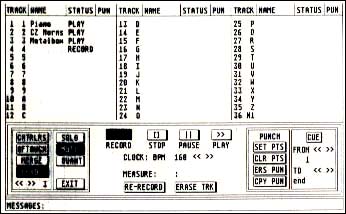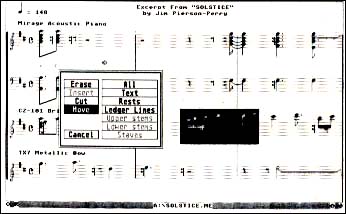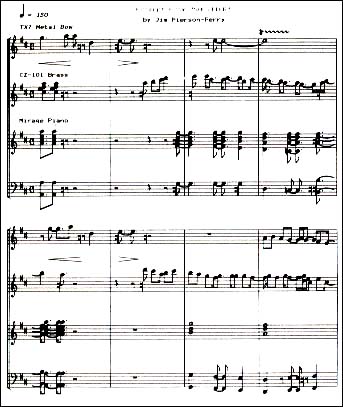MUSIC
Dr. T's Musical Workstation
From Random Thoughts to Finished Score
By Jim Pierson-Perry
Dr. T's Software has just raised the stakes in the ST MIDI software arena. They're the first company to release an integrated MIDI workstation capable of taking your musical ideas through to performance and printed score. The workstation is built around the Keyboard Controlled Sequencer Level II (KCS II) and a multi-program environment (MPE) shell which runs compatible Dr. T programs from within the KCS II. These additional programs currently include The Copyist, for transcribing MIDI data to sheet music, and patch editors for the Yamaha DX7, Roland D-50 and MT-32 synthesizers.
The KCS II is the newest incarnation of Dr. T's premier sequencer. Besides the MPE, they've added two new program modules for advanced editing and algorithmic composition: the Master Editor and Programmable Variations Generator (PVG). You'll need one megabyte of memory to run the KCS II by itself or with a patch editor under MPE; two megabytes or more to run KCS II with The Copyist under MPE.
A full review of KCS II or The Copyist would take more space than this article permits, as well as some background music education. Instead, I'll focus on how to use the workstation by actually producing some music. I'll use an excerpt from a piece I wrote called "Solstice" and show the process from start to finished score, while looking at some of the major features the programs offer.
SETTING UP
The KCS II is used for recording and editing your music in MIDI data format. You begin by configuring the program to fit your MIDI system. The KCS II can accept all data from the ST MIDI In port or be more discriminating and ignore selected controller data. An echo feature lets you play a master keyboard on a single channel and have the MIDI data redirected to a slave synthesizer on another channel.
Proper timing is critical for music. The KCS II lets you specify the tempo (beats per minute), meter (number of beats per measure) and timing resolution (number of internal clock steps per beat). These can be freely changed during recording or editing; audible and visible metronomes are provided while recording. You can use KCS's internal clock or the program can be slaved to an external MIDI clock source; synching to a tape machine is possible using the MIDI Song Pointer.
Three different operating modes are available with the KCS II: track, open and song. Track mode is similar to using a tape recorder. It records a single sequence using up to 48 independent simultaneous tracks, each holding data from any or all MIDI channels (see Figure 1.) Open mode is more powerful and lets you manipulate up to 128 sequences of different lengths. These can be started, stopped, looped for a set number of times and modified in real-time or under the control of other sequences. You can record new sequences while listening to the playback. Song mode is a restricted form of open mode where sequences are strung together, like a drum machine, and cannot overlap. Musical data can be freely exchanged between these three modes. I prefer to record sequences in track mode, then go to open mode and explore various ways of editing and structuring them to create the final composition.
 |
| Figure 1: KCS Level II "Track Mode" record screen. |
RECORDING
The excerpt from "Solstice" uses only three instruments: Mirage sampler for a piano sound, Casio CZ-101 for brass section and Yamaha TX7 for a hybrid metallic string sound. I used a master keyboard to send notes and controller values on MIDI channel one into the KCS II and echo back to the slave synthesizers.
I first played the piano part onto track one which sets the length of all tracks. This track replayed constantly (looped) while I added other tracks. As each new track is recorded, it joins in the playback cycle. Individual tracks can be soloed or desired track mixes can be heard by muting the remaining ones.
If you flub a part, just erase the current recording track and try again. For a blip in an otherwise good track, the problem region can be selected with the punch in/out buttons, rerecorded on another track and merged to make the correction. More sophisticated corrections can be done on the raw MIDI data itself using edit functions. For more demanding parts, a step entry feature can be used to enter note pitch, velocity and timing.
You can do some editing "on the fly" while recording or during replay. Examples of this are quantizing MIDI events to fit a time grid, deleting bad notes and altering velocities (loudness) using a volume pedal or other controller. Additional track operations are merge, delete, swap track order and shift a track forward or backward in time. The latter is great for chorus or echo effects.
I did run into one nasty bug: If you have a modem attached to your ST, turn it off when recording; otherwise if your phone rings the program crashes. This only happens when recording and not during other program operations.
CREATIVE EDITING
The KCS II is unsurpassed in its number and richness of editing features, which you can use to correct, embellish, add, alter or just play with any of the MIDI events. You can edit almost anything on the event list; a tabulation of all MIDI activities for a given track or sequence, synched to time, appears in the edit screen. Clicking the right mouse button plays the event list, or a selected region of it, giving instant feedback on your editing.
 |
| Figure 2: DX-Heaven. |
Basic editing is done directly on the event list by changing the event values--just like a musical word processor! Many different event types are supported, representing MIDI data as well as edit and control activities. Examples of the latter are meter changes, wait for a specific time cue increase/decrease tempo, start/stop a sequence playing and rest. The KCS II recognizes polyphonic key pressure as separate from aftertouch.
You can apply edit commands to entire sequences or just a specific region, selecting them by clicking and dragging with the mouse on the event list. Common operations include cut, copy, paste, insert, delete, backup, merge tracks, append and split a track into two with respect to MIDI note number. Additional commands provide transpose or invert pitch, velocity and duration values; standardize timing; strip controller data; scale velocity (give a fade in/out effect); compress/expand overall timing; reassign MIDI channels and reverse event order (play music backwards).
The Master Editor invokes even more extensive operations. Notes in the current sequence can be selectively blended with a reference sequence according to a variety of criteria. Chord options let you collect a series of notes to be played as a chord or separate a chord into an arpeggio and play the notes on specified MIDI channels. Controller data can be thinned to decrease the MIDI data density, split out to a separate sequence or erased entirely. You can even remap pitches in a sequence--particularly useful with drum machines that use different note assignments for their sounds.
For "Solstice," I changed the event list to correct a few bad notes, added velocity scaling, adjusted the overall timing and used the Master Editor to solidify chord timings. All of that took about 15 minutes. In general, the KCS II editing functions are well implemented and easy to use, once you become familiar with the structure of the event list.
Two features I would like to see added are remapping controllers (e.g., use the modulation wheel to control stereo panning) and graphical editing of velocity and controller data for greater flexibility in adding music dynamics.
NEW SOUNDS FOR OLD
Listening to the playback, I decided to change the TX7 voice timbre. I'd set it as a string sound but now I wanted more "bite" to it to compete with the horns. Selecting EXT from the KCS II edit screen activated the MPE shell program loader and I brought in the DX Heaven patch editor program. This installed a new edit option and I could toggle back and forth between the two programs. Up to four such programs can be installed under MPE (memory permitting) and removed when no longer needed, restoring memory.
 |
| Figure 3: The Change Menu from the Programmable Variations Gener- ator, KCS Level II. |
The MPE version of DX Heaven is similar to previous incarnations except it's now possible to play a KCS II sequence through it. You can change patches and hear the results in context. Playback can be an entire sequence, from a cue or a highlighted region of the event list. Only the original Yamaha DX7 and compatibles are supported, not the new DX7 II or TX802.
DX Heaven has a good graphical user interface. You can store up to eight patch banks in memory and set patch parameters using an onscreen slider, the + or - keys, the mouse or just by typing the new values. Operator envelopes can be graphically edited by dragging the data points to desired new locations (see Figure 2.)
I used the patch editor to add a metallic edge to the TX7 string sound, something like playing a saw. Being able to playback the KCS II sequence without leaving DX Heaven let me quickly make changes and hear how they sounded with the other voices in "Solstice."
"ONE STEP BEYOND" EDITING
The PVG module in KCS II is powerful and complex enough to deserve an article on its own. Briefly, it allows for both multi-stage editing and generation of new music based on user-specified combinations of fixed rules and random chance in applying them. The rules and probabilities for a particular operation are called a preset and multiple presets can be strung together to build macros. New sequences can be built as variations on the original MIDI data or evolving chains of new variations from previous ones.
Presets can be applied to all types of MIDI data and multiple combinations of them, as shown in Figure 3. Various factors can be protected from change or restricted from occurring in the variations. Some simple examples are to add or vary controller effects, create chords, add swing to the timing, change the key of a sequence and create random improvisations on pitch and velocity. These barely scratch the surface of uses for the PVG!
I did not use the PVG with "Solstice" but have spent hours experimenting with it. A fascinating exercise is to start with a simple phrase and repeatedly process it through a series of presets. The results can be surprisingly complex and haunting; an audio analogy of the "Life" computer game, where complex "organisms" grow from simple starting patterns.
 |
| Figure 4: An editing screen from The Copyist. |
EVEN THE SCORE
Having recorded, edited and listened to the song, it's time to transcribe the MIDI data into standard musical score format using The Copyist. Not having a Mega, I ran it as a standalone program. Only track mode files can be scored; open or song mode sequences must be copied to track mode in the KCS II. In addition, only the first 24 tracks can be read; any extras must be merged and mixed down to 24 or fewer. The program also can be used with music files in the Steinberg and MIDI sequence file standard formats.
You specify the type of clefs to be used with each individual track. Treble, alto, bass and drum clefs are supported. A track can be assigned to a single clef or split across two. The number of bars per line (1 to 8), staves per page (6 to 16), key signature and meter also are specified at this point. The next step is to enter edit mode and set various style elements for the score presentation.
Once the score appears on the page, you can edit both symbols and text. A large symbol library is available and you can define up to ten special symbols with the supplied font editor. You can use the mouse for cut/paste and positioning through the screen display; moving between pages requires keyboard commands (see Figure 4). New features in this version include additional dynamic markings, several text styles, slurs and guitar tablature symbols. Transcription takes note pitch and timing into consideration. Dynamics and controllers are ignored; you must add them by editing.
Draft printing to an Epson compatible can be done from the edit screen. Using the print menu option allows for high resolution output to the Epson, HP Laserjet or HP-GL compatible plotter. A page printout in draft mode takes about five minutes; high resolution mode takes about 18 minutes, a 30% speed increase over earlier versions of The Copyist. The example printout for the first page of "Solstice" in Figure 5 shows the excellent quality you can obtain with an Epson printer.
Beyond scoring, additional options are to extract individual parts from a score and convert a score backwards into a sequencer file. Extracted parts can be for up to any clefs from the original piece and may be individually transposed and printed. When converting the score to sequence, only the notes and timing go over--all velocities are normalized.
While The Copyist can produce quality transcriptions, it's a very difficult program to use. It was ported from the IBM world and uses a large number of keyboard command sequences with only a token amount of GEM. The problem is compounded by a poor manual, making it almost an adventure game to use the program. Fortunately, a new manual has been written and should be available by the time you read this.
 |
| Figure 5: An example score printout from The Copyist, done on an Epson printer. |
FINAL IMPRESSIONS
Having gone from recording to scoring, I am extremely impressed by the power and potential of Dr. T's MIDI workstation. The programs work well with each other and represent state-of-the-art performance for ST MIDI software.
The KCS II is a tremendous tool for composition and experimentation. It's not as friendly as some other programs, but is logical, once you understand the system, and efficient. A major complaint with previous versions was the manual--KCS II comes with a clearly-written manual (with a good index) in a three-ring binder. Hurrah! DX Heaven, like the others in the Caged Artist series, is an excellent patch editor that makes good use of the ST graphics and mouse.
On the down side, the MPE is fairly limited--at least with the programs currently available. I would like to run any GEM program from MPE, not just those from Dr. T, and the memory requirements to include KCS II with The Copyist are beyond the reach of most ST users. Rather than dragging entire patch editors into MPE two or three at a time, often all you need is a simple patch loader that could handle all your MIDI gear at once and be called automatically from within a sequence. Another concern is that The Copyist still needs substantial improvement on the user interface.
But even with these reservations, Dr.T has clearly delivered on his promise for "software to unleash your imagination" and flung the gauntlet down for the next round of MIDI software escalation. What a time to be a musician!
Jim Pierson-Perry is a research chemist and semiprofessional musician, living in Maryland. He is a frequent contributor to START, and recently won the 1988 "Contributor of the Year" award from Antic Magazine.
PRODUCTS MENTIONED
Keyboard Controlled Sequencer Level II, $325; DX Heaven Version 2.0, $129; The Copyist, $225. Dr. T's Music Software Inc., 220 Boylston Street, Suite 306, Chestnut Hill, MA 02167, (617) 244-6954.